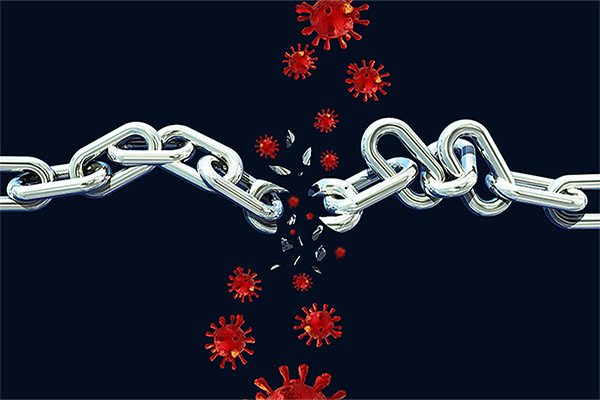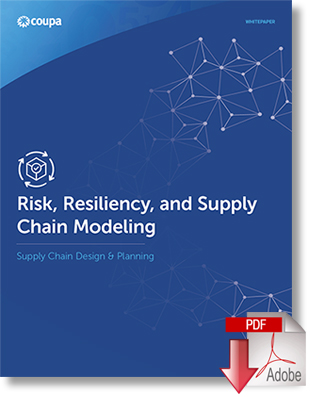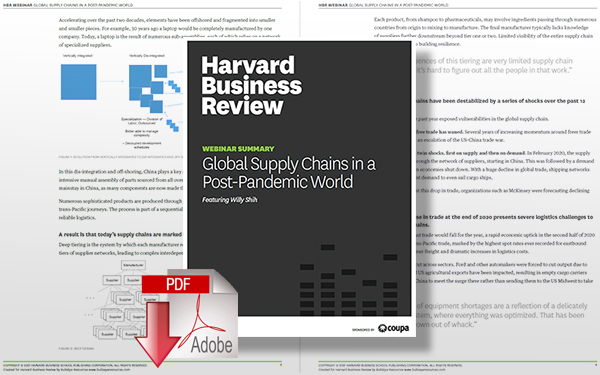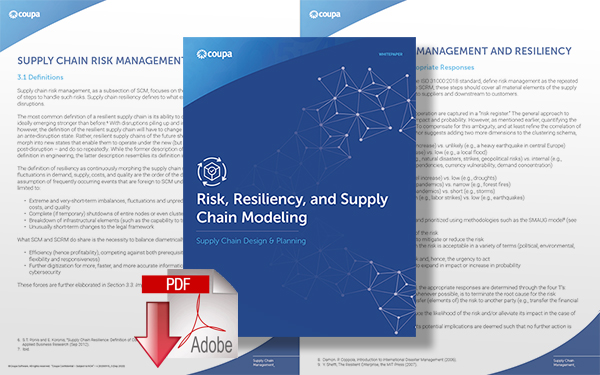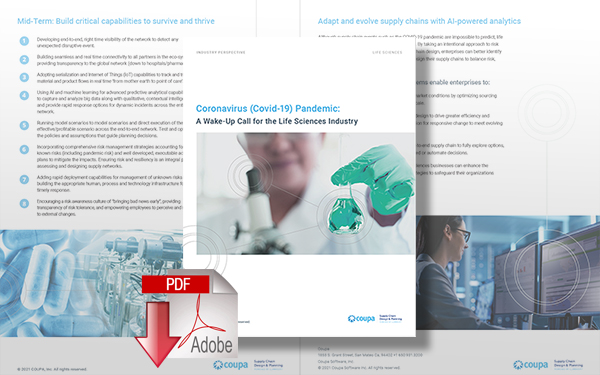Predicting Unprecedented Disruptions in the Supply Chain
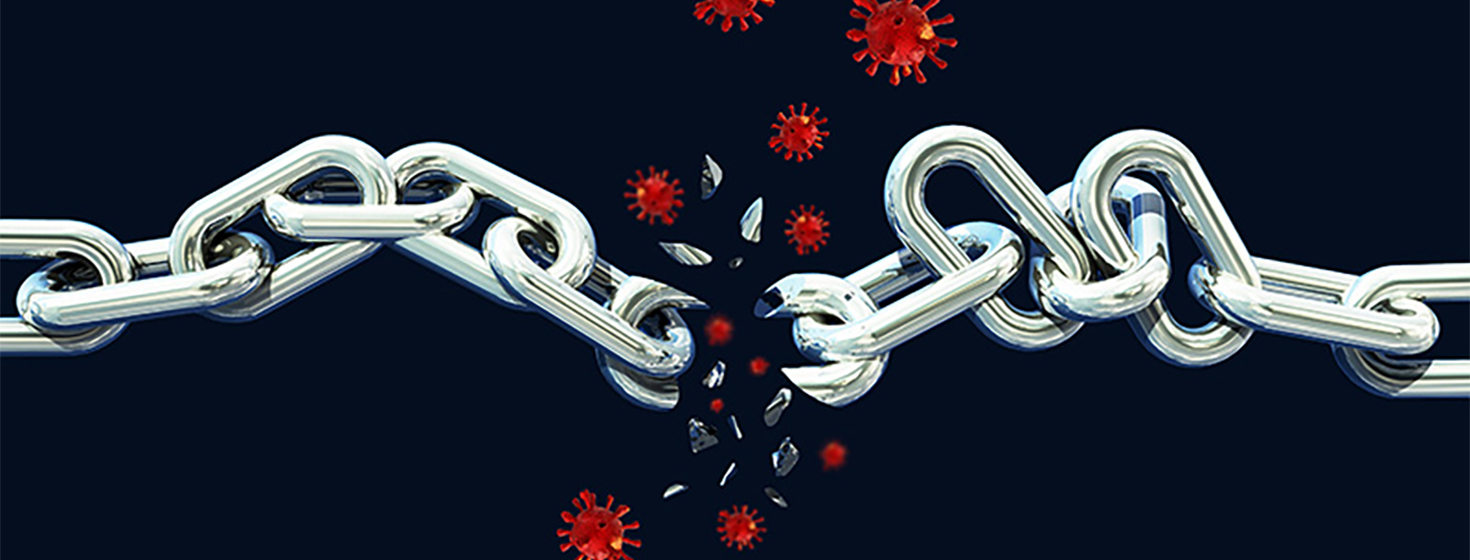
Protecting your supply chain from costly disruptions requires rethinking the least-cost or overly lean strategies that have dominated global supply chains for decades.
Supply Chain Disruption
It can be difficult to predict an unprecedented disruption such as the COVID-19 pandemic. It has demonstrated that even what was thought to be the best-designed supply chains are vulnerable to the risks of unforeseen disruption.
While there is no denying the importance of confident communication and transparency during a crisis, it is equally critical for business leaders to have a confident understanding of disruption impacts, consequences, and actions to take to make the appropriate trade-offs and restore operations as quickly as possible.
Business leaders are redefining what they classify as risk and how they balance that with cost and service for competitiveness in the marketplace. Protecting your supply chain from costly disruptions requires rethinking the least-cost or overly lean strategies that have dominated global supply chains for decades.
Resilient supply chains are often diversifying the geography of their supply base, shifting away from exclusively low-cost/high-risk manufacturing facilities, and increasing inventory and nearshoring.
The question is how to balance risk reduction with supply chain efficiency to assure supply while staying competitive in the marketplace during unpredictable and volatile times.
Supply Chain Disruption Checklist
This checklist can help you understand the near- and long-term steps to consider during a supply chain disruption while laying the foundation for greater resilience across the extended supply chain.
NEAR-TERM: Mast Fast, Data-Driven Decisions to RESTORE Operations
1. Determine Exposure Level
- Work with sourcing departments to determine exposure level by product
- Communicate early and often with customers, suppliers, and trading partners | Understand and acknowledge strategic missteps with your supply chain and communicate plans to address them | Strengthen existing relationships and work jointly on proactively resolving problems
- Map out the extended supply chain to the greatest extent possible | Identify suppliers at tier 2, tier 3, and beyond – these don’t need to be included in modeling and planning, knowing who and where these suppliers are can help reduce the time to identify problems
- Run a where-used check-in your ERP to determine finished goods impact | Determine which final products will be impacted, then: Run sales report for impacted finished goods by the customer to determine potential revenue and/or health and human safety impacts | Check customer/product specific service level agreements and assess potential exposure
- Identify alternative sources of supply
- Establish a recovery plan with strategic suppliers and trading partners
- Actively monitor real-time information across global sources – news feeds, weather data, cargo tracking
2. Evaluate Substitutions
- Identify substitutes and alternatives | Where key customer supply is at risk, look for opportunities to potentially change specifications to offer substitute products with similar functionality Identify interchangeable components and areas where a substitution is an option (this process is known as Supersession in SAP systems) Substitute or offer alternative products where possible
- Evaluate engineering change orders where possible – i.e. re-engineer product to put a different component in the finished product
- Secure alternate logistics capacity/expedite as needed
3. Evaluate Inventory
- Analyze safety stock buffers
- Prioritize and increase inventory levels where possible
- Secure inventory reservations for key customers to ensure availability | Leverage cost to serve analysis to prioritize delivery to customers and maximize profit
- Review Available to Promise expectations and when the original demand could be filled in the future
- Be proactive about backorder behavior and look at potential financial incentives to keep customers waiting instead of canceling and finding an alternative
- Determine potential shifts in demand that may occur when a product is no longer available, as slower-moving products may experience rapid and sustained sales momentum
LONG-TERM Strengthen the Foundation for Continuous Adaptability and Responsiveness
4. Enhance Network Resilience
- Establish long-term goals for adaptability and agility
- Create a digital twin to gain visibility of complete extended supply chain | Long-term – assets beyond tier 1 to understand suppliers and their backups
- Assess network risk profile, identifying areas of high concentration and limited sourcing options
- Identify opportunities for an adjustment (sourcing, inventory levels, and location, logistics) Run a where-used check-in your ERP to determine finished goods impact
- Identify alternative product flow paths should a warehouse or DC shut down
- Validate trade-offs in cost to serve against alternative network options
- Adopt a strategy for dynamic sourcing and design
5. Create A Framework For Faster, Smarter Decision Making
- Establish a backup plan and means to measure impacts
- Create a playbook of scenarios that are ready to be implemented as contingency plans
- Create a cross-functional “wargame” team to drive what-if scenario development that supports and enhance risk mitigation playbooks | Incorporate perspectives on the network and investment in the modeling exercise, while ensuring that business acumen and foresight is a driver in preventative supply chain resiliency tests
- Determine a backup plan and circulate it among all relevant stakeholders
- Be prepared to mobilize a coordinated response to sudden shocks or events
- Maintain the digital twin as a means to quickly assess current and changing conditions | In instances when a playbook fails to envision the risk event, an updated digital twin can quickly provide guidance and insights on how to best respond
- Communicate early, clearly, and frequently
ADAPT and EVOLVE
Take an intentional approach to combat disruption by implementing a continuous supply chain network design.
You will be better positioned with a strategy that includes an acceptable level of risk and maps out options based on impact for the best response.
Coupla Supply Chain Design & Planning powered by LLamasoft offers you a way to balance risk trade-offs with the ability to model, optimize, and simulate your supply chain network operations.
Find the best transportation routes and inventory levels for the current state, then proactively prepare for potential supply chain risk events.
Contingency plans are easier with the capability to run scenarios associated with disruptive events. React quickly to new variables, on the shortest of notice, with models to accelerate the time between making decisions and executing them.
RESTORE | ADAPT | EVOLVE
Webinar Thu, Apr 15, 2021, 12:00 PM: Continuous Design for Supply Chain Resiliency featuring Forrester
Related Resources
Global Supply Chains in a Post-Pandemic World
In this webinar summary, Willy Shih, Robert and Jane Cizik Professor of Management Practice in Business Administration at Harvard Business School, shares insights into how global supply chains came to be the way they are and how their vulnerability has been revealed through numerous crises. Download Now!
Risk, Resiliency, and Supply Chain Modeling
This paper first examines why existing supply chain management practices do not naturally develop resilient supply chains and why some of the existing supply chain processes are not suitable for addressing such risks and required responses. Download Now!
A Wake-Up Call for the Life Sciences Industry
In this industry perspective paper, we detail how, even though supply chain events such as the COVID-19 pandemic are impossible to predict, life sciences organizations can at least, be prepared by taking an intentional approach to risk management, response, and continuous supply chain design. Download Now!
More Resources from Coupa
Related Article: Demand Planning, AI, and Agile Decision Making, Solves Anticipated Cargo Demand
Article Topics
Coupa News & Resources
How Microsoft Improved ESG & Sustainable Spending Working Together with Community.ai Capabilities Supply Chain Agility in an Ever-Changing World How Sourcing Can Respond in Dynamic Markets to Drive Supply Chain Value Build Resilience in Supply Chains by Modeling & Designing Multiple Demand Futures Beyond Disruptions: Building the Next Generation of Resilient Supply Chains 6 Truths About Business Spend Management Technology 5 Ways Supply Chains Can Flourish in an Inflationary World More CoupaLatest in Supply Chain
A Look at Baltimore’s Key Bridge Collapse—One Month Later European Parliament Passes New Law Requiring Supply Chain Accountability Baltimore Continues Bridge Recovery With Opening of New Channel How Shippers Can Prep for Hurricane Season Apple Accused of Multiple Human Rights Violations South Korea Finally Overtakes China in Goods Exported to U.S. UPS Struggles in First Quarter With Steep Earnings Decline More Supply Chain